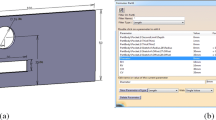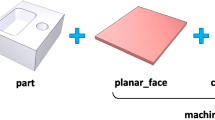Abstract
Traditional adaption of CAD geometry, which plays an important role in generating effective and fit-for-purpose finite element models, is usually carried out manually and optionally with excessive dependence on engineer’s experience. Automatic and efficient geometry modification before simulation evidently improves design efficiency and quality, and cuts down product life cycle. This paper represents an automatic approach to generate simplified and idealized geometry models for CAE simulation, which consists of hybrid model simplification criteria, feature-based model simplification, and simulation intent driven geometry modification. Hybrid adaption criteria takes detailed features geometric dimension, geometry topology, design intent into consideration synthetically. Simulation intent-driven modification with the help of virtual topology operators helps to deal with geometry at a higher level to get an ameliorative boundary for mesh without perturbing the original design model with constructing history for down-stream manufacture-oriented application, such as machining feature recognition and process planning. Development of plug-in toolkit guarantees automation of the simplification process and helps generate simulation-fitted geometry for subsequent analysis and simulation process. Prototype system and cases are implemented to demonstrate the result and efficiency of the proposed approach.



























Similar content being viewed by others
References
Thakur A, Banerjee AG, Gupta SK (2009) A survey of CAD model simplification techniques for physics-based simulation applications. Comput Aided Des 41(2):65–80
Kwon S, Kim BC, Mun D, Han S (2015) Simplification of feature-based 3D CAD assembly data of ship and offshore equipment using quantitative evaluation metrics. Comput Aided Des 59:140–154
Nolan DC, Tierney CM, Armstrong CG, Robinson TT (2015) Defining simulation intent. Computer-Aided Design 59:50–63
Foucault G, Cuillière JC, François V, Léon JC, Maranzana R (2013) Generalizing the advancing front method to composite surfaces in the context of meshing constraints topology. Comput Aided Des 45(11):1408–1425
Gujarathi GP, Ma YS (2011) Parametric CAD/CAE integration using a common data model. J Manuf Syst 30(3):118–132
Sanfilippo EM, Borgo S (2016) What are features? An ontology-based review of the literature. Comput Aided Des 80:9–18
Lee SH, Lee K (2012) Simultaneous and incremental feature-based multiresolution modeling with feature operations in part design. Comput Aided Des 44(5):457–483
Kim BC, Mun D (2014) “Feature-based simplification of boundary representation models using sequential iterative volume decomposition. Comput Graph 38:97–107
Mounir H, Nizar A, Borhen L, Benamara A, Deneux D (2013) FEM simulation based on CAD model simplification: a comparison study between the hybrid method and the technique using a removing details. In: Haddar M, Romdhane L, Louati J, Ben Amara A (eds) Design and modeling of mechanical systems. Springer, Berlin, Heidelberg
Mun D, Ramani K (2011) Knowledge-based part similarity measurement utilizing ontology and multi-criteria decision making technique. Adv Eng Inform 25(2):119–130
Mun D, Kim BC (2017) Extended progressive simplification of feature-based CAD models. Int J Adv Manuf Technol 93:915–932
Kwon S, Mun D, Kim BC, Han S (2016) Feature shape complexity: a new criterion for the simplification of feature-based 3D CAD models. Int J Adv Manuf Technol 88:1831–1843
Woo Y (2014) Abstraction of mid-surfaces from solid models of thin-walled parts: a divide-and-conquer approach. Comput Aided Des 47:1–11
Boussuge F, Léon J-C, Hahmann S, Fine L (2014) Extraction of generative processes from B-Rep shapes and application to idealization transformations. Comput Aided Des 46:79–89
Boussuge F, Léon J-C, Hahmann S, Fine L (2014) Idealized models for FEA derived from generative modeling processes based on extrusion primitives. Eng Comput 31(3):513–527
Bidarra R, Madeira J, Neels WJ, Bronsvoort WF (2005) Efficiency of boundary evaluation for a cellular model. Comput Aided Des 37(12):1266–1284
Sun R, Gao S, Zhao W (2010) An approach to B-rep model simplification based on region suppression. Comput Graph 34(5):556–564
Chen J, Cao B, Zheng Y, Xie L, Li C, Xiao Z (2015) Automatic surface repairing, defeaturing and meshing algorithms based on an extended B-rep. Adv Eng Softw 86:55–69
Sheffer MBA (2000) Virtual topology operators for meshing. Int J Comput Geomet Appl 10(3):309–331
Foucault G, Cuillière J-C, François V (2008) Adaptation of CAD model topology for finite element analysis. Comput Aided Des 40(2):176–196
Cuillière J-C, Francois V, Drouet J-M, Automatic mesh generation and transformation for topology optimization methods. Computer-Aided Design 45:1489–1506
Cuillière J-C, François V, Lacroix R (2016) A new approach to automatic and a priori mesh adaptation around circular holes for finite element analysis. Comput Aided Des 77:18–45
Tierney CM, Sun L, Robinson TT, Armstrong CG (2015) Generating analysis topology using virtual topology operators. Proc Eng 124:226–238
Xia Z, Wang Q, Wang Y, Yu C (2015) A CAD/CAE incorporate software framework using a unified representation architecture. Adv Eng Softw 87:68–85
Xia Z, Wang Q, Liu Q, Wang Y, Liu J, Chen G (2016) A novel approach for automatic reconstruction of boundary condition in structure analysis. Adv Eng Softw 96:38–57
Zhan P, Jayaram U, Kim O, Zhu L (2010) Knowledge representation and ontology mapping methods for product data in engineering applications. J Comput Inf Sci Eng 10(2):021004
Hamri O, Léon JC, Giannini F, Falcidieno B (2010) Software environment for CAD/CAE integration. Adv Eng Softw 41:1211–1222
Park HS, Dang XP (2010) Structural optimization based on CAD–CAE integration and metamodeling techniques. Comput Aided Des 42(10):889–902
Louhichi B, Abenhaim GN, Tahan AS (2014) CAD/CAE integration: updating the CAD model after a FEM analysis. Int J Adv Manuf Technol 76:391–400
J Wang et al (2016) A CAD/CAE-integrated structural design framework for machine tools. Int JAdv Manuf Technol 91:545–568
Author information
Authors and Affiliations
Corresponding author
Additional information
Publisher’s Note
Springer Nature remains neutral with regard to jurisdictional claims in published maps and institutional affiliations.
Rights and permissions
About this article
Cite this article
Feng, Q., Zhou, X. & Li, J. A hybrid and automated approach to adapt geometry model for CAD/CAE integration. Engineering with Computers 36, 543–563 (2020). https://doi.org/10.1007/s00366-019-00713-4
Received:
Accepted:
Published:
Issue Date:
DOI: https://doi.org/10.1007/s00366-019-00713-4




